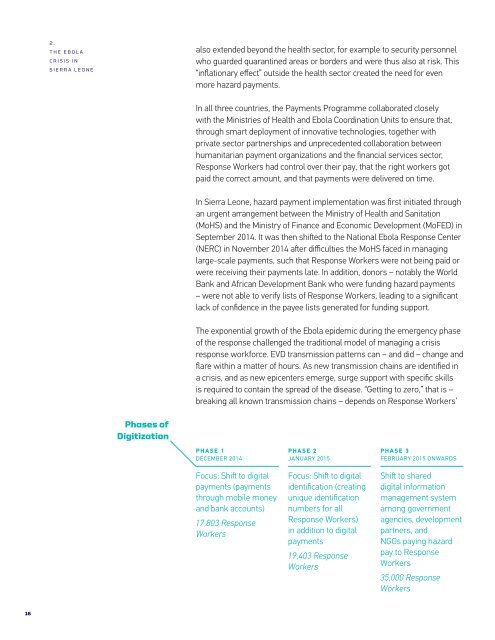LEONE
1U6Dtu2
1U6Dtu2
You also want an ePaper? Increase the reach of your titles
YUMPU automatically turns print PDFs into web optimized ePapers that Google loves.
2 .<br />
THE EBOLA<br />
CRISIS IN<br />
SIERRA <strong>LEONE</strong><br />
also extended beyond the health sector, for example to security personnel<br />
who guarded quarantined areas or borders and were thus also at risk. This<br />
“inflationary effect” outside the health sector created the need for even<br />
more hazard payments.<br />
In all three countries, the Payments Programme collaborated closely<br />
with the Ministries of Health and Ebola Coordination Units to ensure that,<br />
through smart deployment of innovative technologies, together with<br />
private sector partnerships and unprecedented collaboration between<br />
humanitarian payment organizations and the financial services sector,<br />
Response Workers had control over their pay, that the right workers got<br />
paid the correct amount, and that payments were delivered on time.<br />
In Sierra Leone, hazard payment implementation was first initiated through<br />
an urgent arrangement between the Ministry of Health and Sanitation<br />
(MoHS) and the Ministry of Finance and Economic Development (MoFED) in<br />
September 2014. It was then shifted to the National Ebola Response Center<br />
(NERC) in November 2014 after difficulties the MoHS faced in managing<br />
large-scale payments, such that Response Workers were not being paid or<br />
were receiving their payments late. In addition, donors – notably the World<br />
Bank and African Development Bank who were funding hazard payments<br />
– were not able to verify lists of Response Workers, leading to a significant<br />
lack of confidence in the payee lists generated for funding support.<br />
The exponential growth of the Ebola epidemic during the emergency phase<br />
of the response challenged the traditional model of managing a crisis<br />
response workforce. EVD transmission patterns can – and did – change and<br />
flare within a matter of hours. As new transmission chains are identified in<br />
a crisis, and as new epicenters emerge, surge support with specific skills<br />
is required to contain the spread of the disease. “Getting to zero,” that is –<br />
breaking all known transmission chains – depends on Response Workers’<br />
Phases of<br />
Digitization<br />
PHASE 1<br />
DECEMBER 2014<br />
Focus: Shift to digital<br />
payments (payments<br />
through mobile money<br />
and bank accounts)<br />
17,803 Response<br />
Workers<br />
<br />
PHASE 2<br />
JANUARY 2015<br />
Focus: Shift to digital<br />
identification (creating<br />
unique identification<br />
numbers for all<br />
Response Workers)<br />
in addition to digital<br />
payments<br />
19,403 Response<br />
Workers<br />
PHASE 3<br />
FEBRUARY 2015 ONWARDS<br />
Shift to shared<br />
digital information<br />
management system<br />
among government<br />
agencies, development<br />
partners, and<br />
NGOs paying hazard<br />
pay to Response<br />
Workers<br />
35,000 Response<br />
Workers<br />
16



